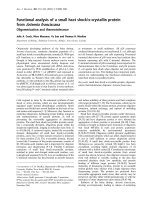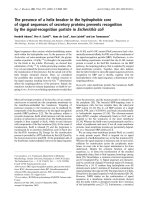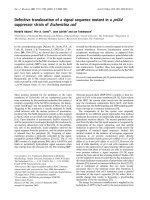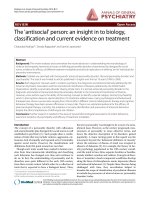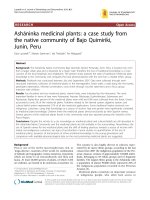Báo cáo y học: "Food-Dependent Exercise-Induced Anaphylaxis: A Case Related to Chickpea Ingestion and Review" docx
Bạn đang xem bản rút gọn của tài liệu. Xem và tải ngay bản đầy đủ của tài liệu tại đây (119.46 KB, 4 trang )
CASE REPORT
Food-Dependent Exercise-Induced Anaphylaxis: A Case
Related to Chickpea Ingestion and Review
Chet G. Wong, HonBSc and Sean R. Mace, MB, BCh, FRCPC
Food-dependent exercise-induced anaphylaxis (FDEIA) is recognized as a distinct category of exercise-induced anaphylaxis (EIA) but
is very likely underdiagnosed. This report describes a 41-year-old Indian woman who experienced two separate episodes of
anaphylaxis while dancing after she had eaten chickpea-containing foods. The chickpea, a small legume, is a staple ingredient in
culinary traditions from around the world, especially in India, the Middle East, and North Africa. Chickpea-containing dishes are also
becoming more widespread in the Western world with the growing popularity of South Asian, Middle Eastern, and African cuisines.
It is important to consider FDEIA in cases of unexplained anaphylaxis as reactions can occur several hours after ingesting the culprit
food(s). Furthermore, no reaction occurs if a sensitized individual eats the culprit food(s) without exercising afterward; therefore,
triggering foods can easily be overlooked. Current ideas on the pathophysiology, predisposing factors, workup, and treatment of
FDEIA are also summarized here.
Key words: anaphylaxis, exercise, food allergy
F
ood-dependent exercise-induced anaphylaxis (FDEIA)
is a type of exercise-induced anaphylaxis (EIA) that
occurs only when a sensitized individual ingests a food
allergen(s) and proceeds to exercise within a certain
window of time; neither the food(s) alone nor exercise
alone is sufficient to induce a reaction. Typical symptoms
of EIA include warmth, flushing, generalized pruritis,
urticaria, angioedema, wheezing, and, in severe cases,
airway obstruction and anaphylactic shock.
1
FDEIA can be
a difficult diagnosis to make because the association
between the inciting food allergen(s) and physical activity
is not always readily apparent; other conditions that share
similar clinical features include food allergy, EIA, asthma,
cholinergic urticaria, and laryngospasm. The following
case report describes an individual who developed EIA
after eating chickpeas and participating in bhangra
dancing, a spirited form of modern dance requiring
significant energy and stamina with origins in the harvest
dances from Punjab.
2
Case Report
The patient was a 41-year-old Indian saleswoman who
works from home and was referred to the allergy clinic
because of a suspected chickpea allergy. She reported two
episodes of anaphylaxis associated with the ingestion of
chickpeas. The first occurred during a party in the summer
of 2005; the patient ate a dish containing chickpea flour at
approximately 7 pm, and within half an hour, she
developed generalized urticaria with facial swelling, mostly
in the periorbital region, while dancing. She did not
experience any dysphagia, wheezing, or breathing difficul-
ties. At midnight that same evening, the patient felt
lightheaded and, after standing up, lost consciousness for
less than 30 seconds. After regaining consciousness, she
had some nausea and vomiting and felt weak. The patient
had not been drinking alcohol at the party and had only
Coca-Cola to drink. None of the other guests at the party
experienced these symptoms. The patient subsequently
went out dancing on other nights without eating chickpeas
and was unaffected. Similarly, she also ate chickpeas on
several occasions without dancing afterward and did not
have any problems. Then, approximately 1 month after her
first reaction, she had another reaction that occurred after
she had eaten chickpeas and gone dancing.
The patient’s past medical history is significant for
hypothyroidism. She does not have any known allergies to
foods or medications, nor does she have any history of
Chet G. Wong: School of Medicine, Queen’s University, Kingston, ON;
Sean R. Mace: Division of Allergy and Clinical Immunology, St.
Michael’s Hospital, University of Toronto, Toronto, ON.
Correspondence to: Dr. Sean R. Mace, 2130 Lawrence Avenue East, Suite
301, Scarborough, ON M1R 3A6.
DOI 10.2310/7480.2007.00011
134 Allergy, Asthma, and Clinical Immunology, Vol 3, No 4 (Winter), 2007: pp 134–137
eczema or asthma, but she does have seasonal allergic
rhinoconjunctivitis. The patient drinks alcohol occasion-
ally and does not smoke. Her family history of atopy
includes a sister who has environmental allergies and a 14-
year-old son who had a childhood allergy to peanuts,
lentils, and other legumes; he outgrew most of these
allergies but remains allergic to chickpeas. The patient’s
medications consist of levothyroxine and an oral contra-
ceptive pill.
A complete physical examination was unremarkable,
and the patient underwent skin-prick testing for chickpeas
and other members of the legume family, including
peanuts, peas, green peas, string beans, and soy; she had
a positive reaction only to chickpeas. A radioallergosorbent
test (RAST) for immunoglobulin E (IgE) antibodies
against chickpeas showed a low titre of 0.47 kU/L. This
was followed by a supervised graded oral challenge, and
the patient tolerated three chickpeas without any con-
sequences.
Discussion
EIA is a well-known phenomenon,
3
and FDEIA has been
recognized as a distinct variant of EIA for almost 30 years,
4
although it is less well understood. In fact, the first case
report of EIA in 1979 described an individual who had
ingested shellfish prior to long-distance running and
subsequently developed anaphylaxis.
5
The true prevalence
and incidence of FDEIA are currently unknown as many
cases remain undiagnosed. FDEIA has not been found to
have a gender or racial bias to date.
There are two types of FDEIA: unspecific FDEIA and
specific FDEIA.
6
Unspecific FDEIA occurs when a
susceptible individual exercises after filling his or her
stomach, regardless of what has been eaten. In specific
FDEIA, the combination of the culprit food antigen(s) and
exercise lowers mast cell degranulation thresholds, leading
to histamine release and anaphylaxis.
7
Thus far, the most
common food implicated in specific FDEIA is wheat, and
molecular studies have identified sequential epitopes in the
repetitive domain of wheat gliadins that are bound by IgE
antibodies in wheat-dependent EIA.
8,9
Other triggering
foods in FDEIA include buckwheat, pistachios, apples,
oranges, corn, mushrooms, and celery.
10–16
The exact pathophysiology of FDEIA has yet to be
determined, but gut permeability is one factor that may
play an important role in the development of FDEIA.
7
An
animal study by Yano and colleagues using lysozyme-
sensitized mice revealed that exercise increased the
gastrointestinal absorption of lysozyme ingested prior to
activity.
17
Interestingly, sensitized mice were found to have
a greater number of mucosal lesions in the small intestine
after exercise than sensitized mice at rest or unsensitized
mice. Although the mechanism of mucosal damage was
not addressed, the authors noted that exercise can cause
significant decreases in mesenteric blood flow and that
intestinal ischemia has been linked to increased bacterial
translocation and absorption of endotoxin from the
gastrointestinal tract. These observations suggest that
mesenteric ischemia could be responsible for failure of
the gastrointestinal mucosal barrier and result in increased
absorption of food allergens into the bloodstream.
Another factor hypothesized to be involved with the
pathophysiology of FDEIA is tissue transglutaminase
(tTG) activity beneath gastrointestinal epithelium.
7
Palosuo and colleagues showed that tTG cross-links
wheat gliadins in individuals with wheat-dependent EIA,
causing the formation of high-molecular-weight com-
plexes with enhanced IgE binding capability.
18
Skeletal
muscle contraction during exercise also increases circulat-
ing levels of tumour necrosis factor a, interleukin-6, and
glucocorticoid hormones, all of which stimulate tTG
activity.
18
Thus, exercise may activate tTG and increase
modification of food-derived peptides, leading to more IgE
cross-linking and mast cell degranulation. However,
whether tTG acts on other food substrates besides gliadin
remains to be seen.
An important consideration in FDEIA is the relation-
ship between the amount of food allergen ingested and the
propensity for an attack. A case report on a young Japanese
woman with wheat-dependent EIA by Hanakawa and
colleagues described a dose-dependent effect of wheat
ingestion on precipitating an allergic reaction.
19
Another
issue of concern is whether medications can influence the
onset of FDEIA. Drug-dependent EIA has been reported in
a patient on a nonsteroidal anti-inflammatory drug
(NSAID),
20
and several Japanese studies have found that
aspirin potentiates FDEIA.
8,21,22
In addition, Matsuo and
colleagues demonstrated that aspirin increased circulating
levels of gliadin in patients with wheat-dependent EIA who
were fed wheat.
8
Notably, circulating levels of gliadin
correlated with FDEIA symptomatology, supporting the
belief that FDEIA is dose dependent. Taken together, these
findings indicate that aspirin use may increase gastro-
intestinal absorption of food allergens and exacerbate
FDEIA.
A reasonable workup for FDEIA would include a
complete history and physical examination, skin-prick
testing, prick + prick testing, applicable RASTs, and food-
exercise provocation testing. With regard to prick tests, an
Wong and Mace, Food-Dependent Exercise-Induced Anaphylaxis 135
Italian study on 54 patients with FDEIA recommended
that those with suspected FDEIA be skin prick tested using
a large panel of foods as patients can have multiple food
triggers.
23
However, this study also revealed that skin-prick
testing, prick + prick testing, and RASTs had variable
sensitivities for diagnosing FDEIA, depending on what the
culprit food was, although in virtually every case, at least
one of the three tests was positive for the suspect food.
Furthermore, each of the three tests found positivities
undetected by the others.
Another study by Harada and colleagues described four
patients with wheat-dependent EIA confirmed by prick
tests, immunoblot tests, and provocation testing who had
negative gluten RAST scores.
24
In the case reported here,
the patient had a positive skin-prick test against chickpeas,
which corroborates her history. Even though her chickpea
RAST score was low, this does not preclude a diagnosis of
chickpea-dependent EIA because there are currently no
data regarding the sensitivity of the chickpea RAST for
identifying such a case.
A formal double-blind placebo-controlled food chal-
lenge (DBPCFC) was not performed in this case. However,
the patient’s history indicated that she was able to tolerate
normal-sized portions of chickpeas without any symptoms
as long as she did not engage in vigorous activity
afterward. There is no universally accepted protocol for
administering a DBPCFC, but such a challenge would
involve giving the patient increasing quantities of the
suspected food allergen or placebo in the form of an
opaque pill or disguised in a liquid medium over 1.5 to 2
hours; if the patient tolerates the equivalent of 10 g of the
dehydrated food without a reaction, it is highly unlikely
that the patient has a food allergy.
25
To determine whether a suspected food is responsible
for FDEIA, it is helpful to do a food-exercise provocation
test. Again, there is no standardized protocol for provoca-
tion testing in cases of suspected FDEIA, but such a test
would involve administering increasing amounts of the
suspected food at regular intervals and then exercising the
subject after each ingestion, with appropriate supervision
and resuscitation equipment ready. However, one must
keep in mind that some patients with FDEIA do not
become symptomatic until several hours later, so a
negative provocation test does not rule out the diagnosis.
The patient described in this case report declined to return
for provocation testing as she was satisfied with our
management plan, which included avoidance of chickpeas
and chickpea-containing foods prior to vigorous activity
and having an epinephrine autoinjector with her at all
times.
As mentioned above, the mainstay of treatment for
FDEIA is avoidance; the time course from ingestion of
food allergen to development of a reaction has not been
established definitively, but the Italian study by Romano
and colleagues found that sensitized individuals did not
have reactions as long as they avoided foods associated
with a positive skin test and/or RAST for at least 4 hours
prior to exercising.
23
In the case reported here, the patient
lost consciousness briefly and then awoke with nausea and
vomiting approximately 5 hours after ingesting the
triggering agent. We believe that these symptoms were
part of her reaction, and a recent report in the literature
describes a similar patient with WDEIA who experienced
loss of consciousness and severe anaphylaxis 5 hours after
wheat ingestion and exercise.
26
Of course, total avoidance
of suspected foods would be ideal. It would also be
prudent for sensitized individuals to avoid NSAIDs and
aspirin if they do plan on ingesting suspected food
allergens. Patients with FDEIA should be advised to carry
an epinephrine autoinjector with them at all times. In an
acute attack, antihistamines, corticosteroids, and/or epi-
nephrine can be used depending on the severity of the
symptoms. Currently, there are no approved prophylactic
agents for FDEIA, although case reports have described
various possibilities including sodium bicarbonate, di-
sodium cromoglycate, and terfenadine.
27–29
The patient described in this report was given a
prescription for an epinephrine autoinjector and
instructed to avoid eating chickpea-containing dishes
prior to dancing or engaging in vigorous physical exercise.
She has not experienced another episode since and
continues to enjoy her usual foods and activities.
References
1. Volcheck GW, Li JT. Exercise-induced urticaria and anaphylaxis.
Mayo Clin Proc 1997;72:140–7.
2. What is bhangra? Available at: />index.php?section52 (accessed November 10, 2006).
3. Castells MC, Horan RF, Sheffer AL. Exercise-induced anaphylaxis.
Curr Allergy Asthma Rep 2003;3:15–21.
4. Kidd JM, Cohen SH, Sosman AJ, Fink JN. Food-dependent
exercise-induced anaphylaxis. J Allergy Clin Immunol 1983;71:
407–11.
5. Maulitz RM, Pratt DS, Schocket AL. Exercise-induced anaphylactic
reaction to shellfish. J Allergy Clin Immunol 1979;63:433–4.
6. Chong SU, Worm M, Zuberbier T. Role of adverse reactions to
food in urticaria and exercise-induced anaphylaxis. Int Arch
Allergy Immunol 2002;129:19–26.
7. Tewari A, Du Toit G, Lack G. The difficulties of diagnosing food-
dependent exercise-induced anaphylaxis in childhood—a case
study and review. Pediatr Allergy Immunol 2006;17:157–60.
136 Allergy, Asthma, and Clinical Immunology, Volume 3, Number 4, 2007
8. Matsuo H, Morimoto K, Akaki T, et al. Exercise and aspirin
increase levels of circulating gliadin peptides in patients with
wheat-dependent exercise-induced anaphylaxis. Clin Exp Allergy
2005;35:461–6.
9. Battais F, Mothes T, Moneret-Vautrin DA, et al. Identification of
IgE-binding epitopes on gliadins for patients with food allergy to
wheat. Allergy 2005;60:815–21.
10. Noma T, Yoshizawa I, Ogawa N, et al. Fatal buckwheat dependent
exercise-induced anaphylaxis. Asian Pac J Allergy Immunol 2001;
19:283–6.
11. Porcel S, Sanchez AB, Rodriguez E, et al. Food-dependent exercise-
induced anaphylaxis to pistachio. J Investig Allergol Clin Immunol
2006;16:71–3.
12. Morimoto K, Hara T, Hide M. Food-dependent exercise-induced
anaphylaxis due to ingestion of apple. J Dermatol 2005;32:62–3.
13. Morimoto K, Tanaka T, Sugita Y, Hide M. Food-dependent
exercise-induced anaphylaxis due to ingestion of orange. Acta
Derm Venereol 2004;84:152–3.
14. Pauls JD, Cross D. Food-dependent exercise-induced anaphylaxis
to corn. J Allergy Clin Immunol 1998;101:853–4.
15. Okano M, Sakuma Y. Food-dependent exercise-induced anaphy-
laxis due to matsutake mushrooms. Br J Dermatol 1997;136:805.
16. Silverstein SR, Frommer DA, Dobozin B, Rosen P. Celery-
dependent exercise-induced anaphylaxis. J Emerg Med 1986;4:
195–9.
17. Yano H, Kato Y, Matsuda T. Acute exercise induces gastro-
intestinal leakage of allergen in lysozyme-sensitized mice. Eur J
Appl Physiol 2002;87:358–64.
18. Palosuo K, Varjonen E, Nurkkala J, et al. Transglutaminase-
mediated cross-linking of a peptic fraction of v-5 gliadin enhances
IgE reactivity in wheat-dependent, exercise-induced anaphylaxis. J
Allergy Clin Immunol 2003;111:1386–92.
19. Hanakawa Y, Tohyama M, Shirakata Y, et al. Food-dependent
exercise-induced anaphylaxis: a case related to the amount of food
allergen ingested. Br J Dermatol 1998;138:898–900.
20. van Wijk RG, de Groot H, Bogaard JM. Drug-dependent exercise-
induced anaphylaxis. Allergy 1995;50:992–4.
21. Harada S, Horikawa T, Ashida M, et al. Aspirin enhances the
induction of type I allergic symptoms when combined with food
and exercise in patients with food-dependent exercise-induced
anaphylaxis. Br J Dermatol 2001;145:336–9.
22. Aihara M, Miyazawa M, Osuna H, et al. Food-dependent exercise-
induced anaphylaxis: influence of concurrent aspirin administra-
tion on skin testing and provocation. Br J Dermatol 2002;146:466–
72.
23. Romano A, Di Fonso M, Giuffreda F, et al. Food-dependent
exercise-induced anaphylaxis: clinical and laboratory findings in 54
subjects. Int Arch Allergy Immunol 2001;125:264–72.
24. Harada S, Iijima M, Nakamura A, et al. Four cases of wheat-
dependent exercise-induced anaphylaxis with negative gluten CAP-
RAST scores. Jpn J Allergol 2007;56:41–8.
25. Sampson HA. Use of food-challenge tests in children. Lancet 2001;
358:1832–3.
26. Oyefara BI, Bahna SL. Delayed food-dependent, exercise-induced
anaphylaxis. Allergy Asthma Proc 2007;28:64–6.
27. Katsunuma T, Iikura Y, Akasawa A, et al. Wheat-dependent
exercise-induced anaphylaxis: inhibition by sodium bicarbonate.
Ann Allergy 1992;68:184–8.
28. Juji F, Suko M. Effectiveness of disodium cromoglycate in food-
dependent, exercise-induced anaphylaxis: a case report. Ann
Allergy 1994;72:452–4.
29. Fujimoto S, Kurihara N, Hirata K, et al. Successful prophylaxis of
wheat-dependent exercise-induced anaphylaxis with terfenadine.
Intern Med 1995;34:654–6.
Wong and Mace, Food-Dependent Exercise-Induced Anaphylaxis 137


